This post may contain affiliate links. We may receive a small commission, at no cost to you, if you make a purchase. Read Disclosure.
China is a massive country, and with only two weeks, it can be hard to know where to start when planning your China itinerary.
Many visitors stop by the main cities: Beijing, Shanghai, and maybe Xi’an, with a few opportunities to get off the beaten path and to experience the beautiful nature of China.
After five years of living in China, I’ve had plenty of experience planning itineraries and showing my friends and family around. Today I’m going to share with you the perfect two week itinerary for China.
The 2 week China itinerary I’ve put together will show you some of the best things to do in mainland China and help you explore the major sights, while also spending some time on the Tibetan Plateau.
Let’s take a look!

2 Week China Itinerary
So, where to go in China? If you only have two weeks at your disposal, you’re going to need to be ok with missing out on a few places.
You will see the most iconic cities such as Beijing and Shanghai, as well as visit some bucket list places such as the Great Wall of China, but you’ll have to save Hong Kong and the southern provinces of China for another trip – there simply isn’t enough time.
Below is the ultimate 14 day China itinerary for those who want to get off the beaten path and see some of the best places to visit in China.
Days 1-3: Beijing
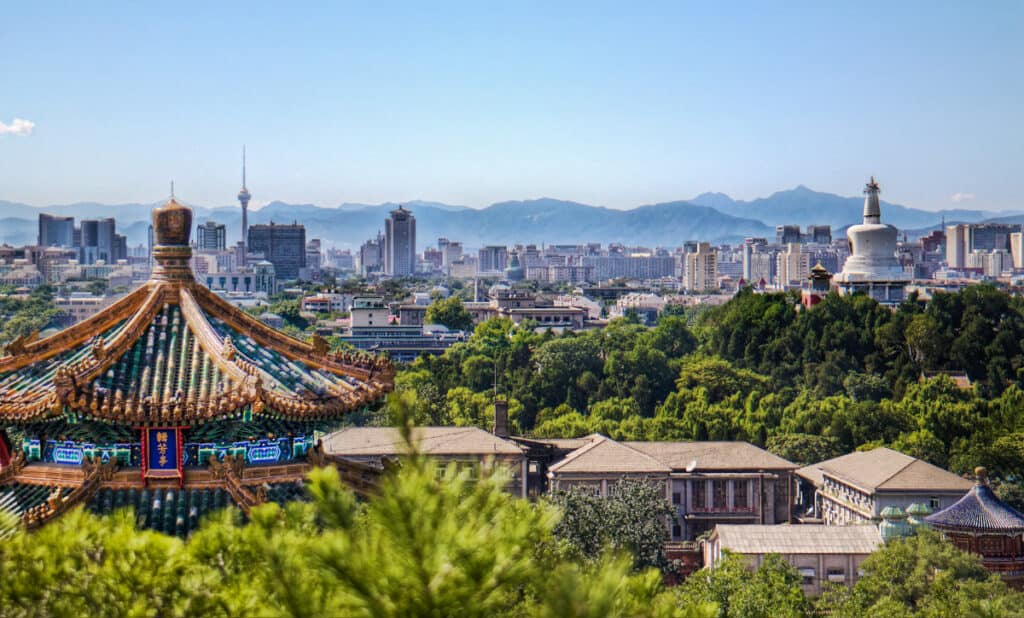
It’s not a trip to China without stopping by the capital city of Beijing.
After a solid two-years of living in Beijing, I might be a bit biased, but there are so many incredible things to do in this city.
From hiking the Great Wall of China to wandering the Forbidden City, and exploring Beijing’s hutongs, you could spend your full two-weeks here and not see everything.
Hike the Great Wall
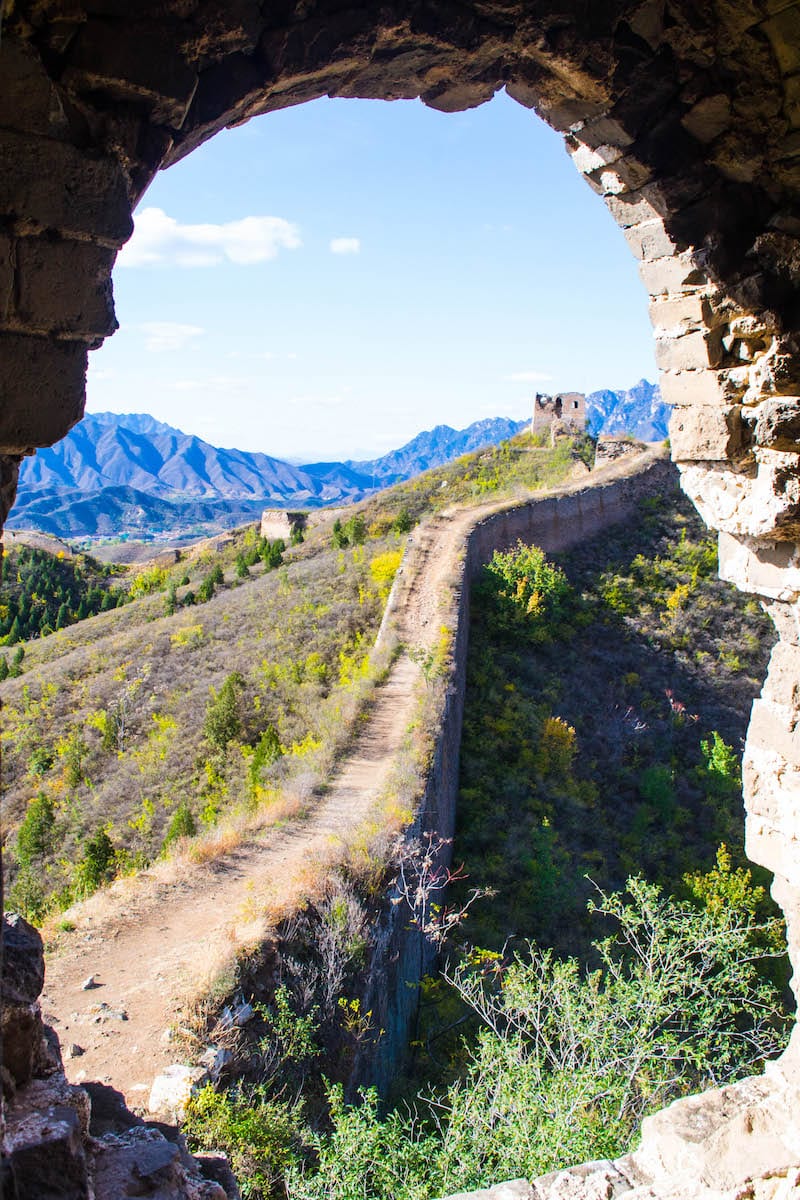
I’m a bit of a Great Wall of China fanatic, and I’ve hiked NINE different sections of the wall. (Yeah, I know I’m a bit obsessed.)
If you want to see the Great Wall the right way, my biggest advice is to get off the beaten path and visit the Wild Wall, a section of the wall not officially open to tourists.
Either that, or visit a part of the great wall that is tourist-friendly, but un-restored. Check out a section like Huanghuacheng, Gubeikou, or Jinshanling.
Whatever you do, I definitely recommend skipping Badaling, the most famous and touristy section of the Great Wall.
If you want a section that’s easy to visit, take a public bus to Mutianyu instead. While you won’t have the wall all to yourself, you’ll avoid the crowds and have incredible views!
Wander the Hutongs
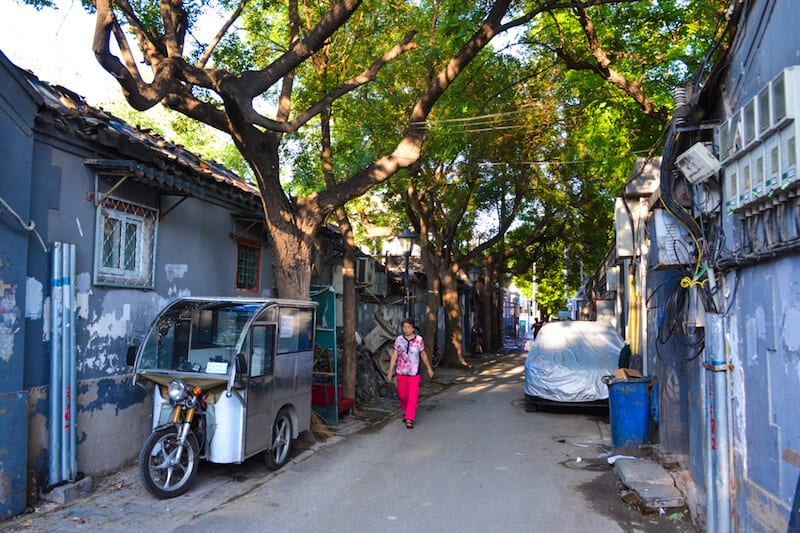
I’m in love with Beijing’s hutongs, a network of traditional alleyway streets and courtyard houses that used to cover all of Beijing.
I’ve shown so many people around the hutongs that I’ve developed my own little hutong-day tour route that covers the Lama Temple, Wudaoying Hutong, the Bell and Drum Towers, and Houhai Lake.
But in my opinion, the best way to visit the hutongs is to simply get lost on your way from A to B.
I also recommend taking a tour of the hutongs to learn more about Beijing’s culture and history.
Viator, a Trip Advisor company, has a hutong and food tour.
Tiananmen Square, Forbidden City, and Jingshan Park
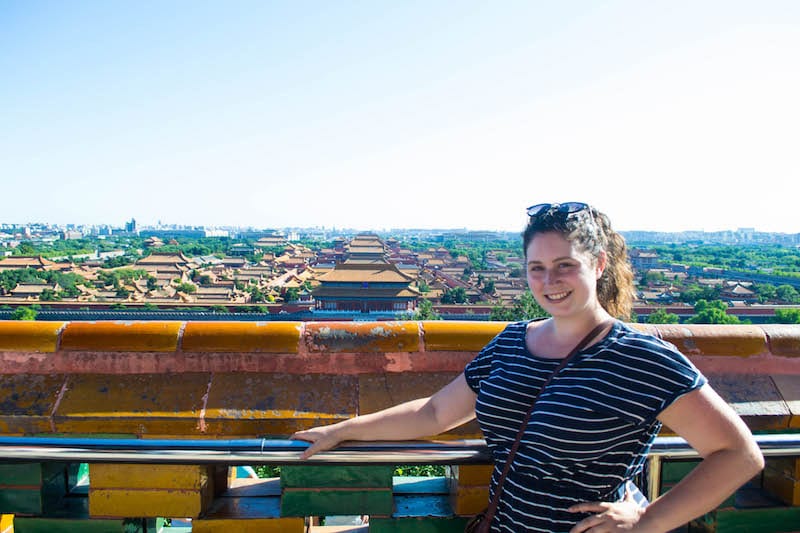
You can’t go to Beijing without seeing the iconic Tiananmen Square with the giant Mao Portrait over the top of the entrance to the Forbidden City.
Spend about 30-minutes wandering around Tiananmen Square, then head into the Forbidden City, where you can explore for about 2 hours.
The Forbidden City is GIANT, and you could easily spend all day there, but for me and most of my family and friends, two hours is just enough to see all of the main sights without getting overwhelmed.
Once you’re finished with the Forbidden City, head to Jingshan Park, where you can catch a view of the Forbidden City (and the rest of Beijing) from above!
If you have more time, then be sure to take a trip out to see the Summer Palace for a quiet retreat from the capital.
If you don’t want to do it on your own, here are a few tour options for you. Click each link to see more details including price, availability and reviews.
Where to stay in Beijing
- For sightseers, the area east of the Forbidden City is full of cheap accommodation.
- For hostels, there’s the well located YHA Peking International Youth Hostel.
- For a budget hotel, friends have enjoyed the modern Hotel Kapok, again right next to the Forbidden City.
- A couple of blocks east you come to Wangfujing where the high-end hotels are clustered.
- The Mandarin Oriental is a personal favourite, and towers over DongHuaMen night market (due to reopen n 2016). Alternatively, look for a family-run traditional courtyard hotel in the same area.
- If you’re going to be spending every night in the bars, it would be more convenient to be over by Sanlitun, where you’ll find most of the expats and backpackers hanging out in Bar Street.
Days 4-6: Xi’an
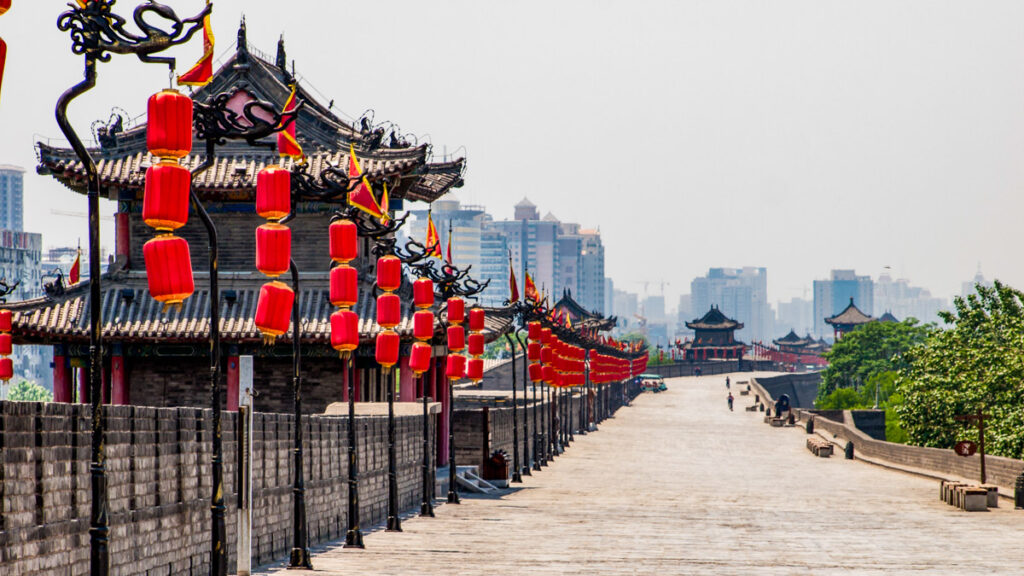
Xi’an is one of my favorite cities in all of China.
This ancient capital is a must-see on your China itinerary and is very easy to get to from Beijing. While it’s tempting to take a quick flight, I actually recommend riding the 4.5 hour high-speed train instead.
Once you factor in arriving at the airport 2 hours early, and how far the airports are from both cities (and the fact that Chinese flights are always delayed), the train ends up being both faster and cheaper than flying!
Bike the Xi’an City Wall
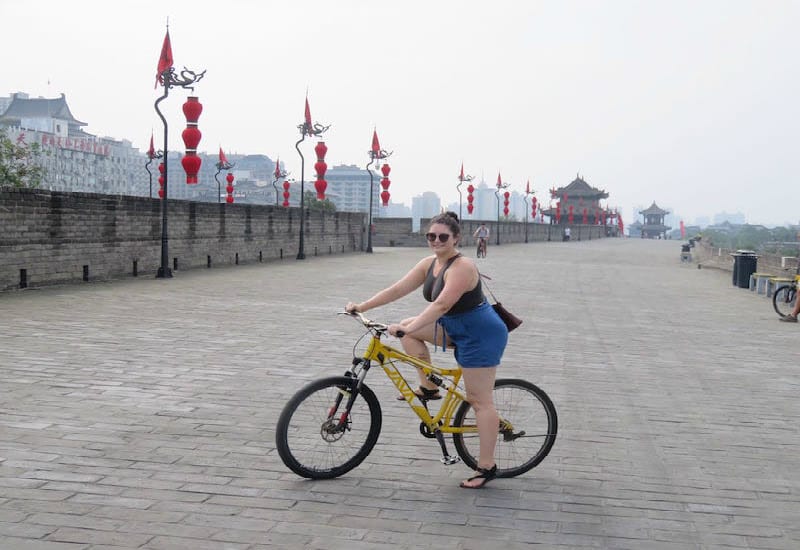
Biking around the ancient city wall is a must on your trip to Xi’an.
You can rent bikes at many of the main gates on the wall, but personally, I recommend starting at the South Gate.
A bike trip around the wall can take anywhere from 1-2 hours depending on how often you stop for photos. Not only will you get to explore this ancient site by bike, you’ll have a view of all of downtown Xi’an from the wall!
Once you get off the wall I definitely recommend exploring the art and caligraphy district near the South Gate.
There are so many shops and souvenirs in the area, and it’s a beautiful neighborhood to photograph.
Explore the Huiminjie Muslim Market
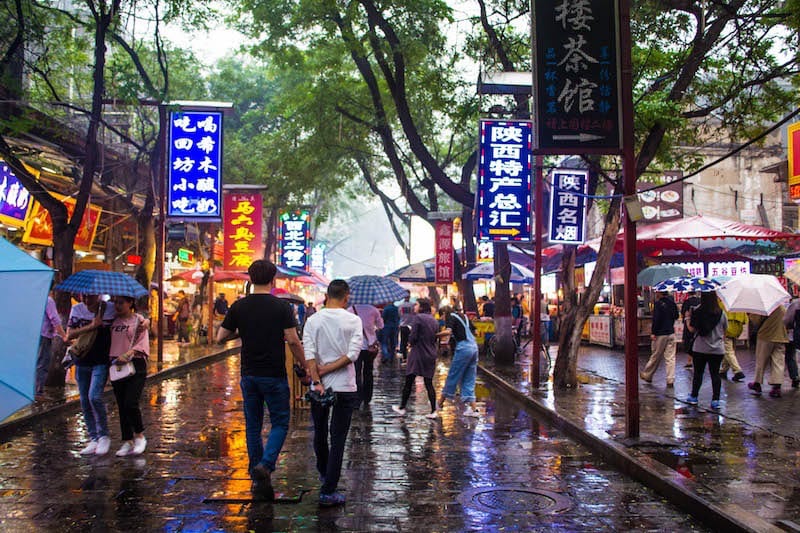
The best time to head to the Muslim Market is just before dinner.
Eat your heart out at the many food stalls, and wander through the souvenir area to bargain for things to take home.
While you’re here, be sure to try local lamb kebabs and liangpi noodles!
Terracotta Army
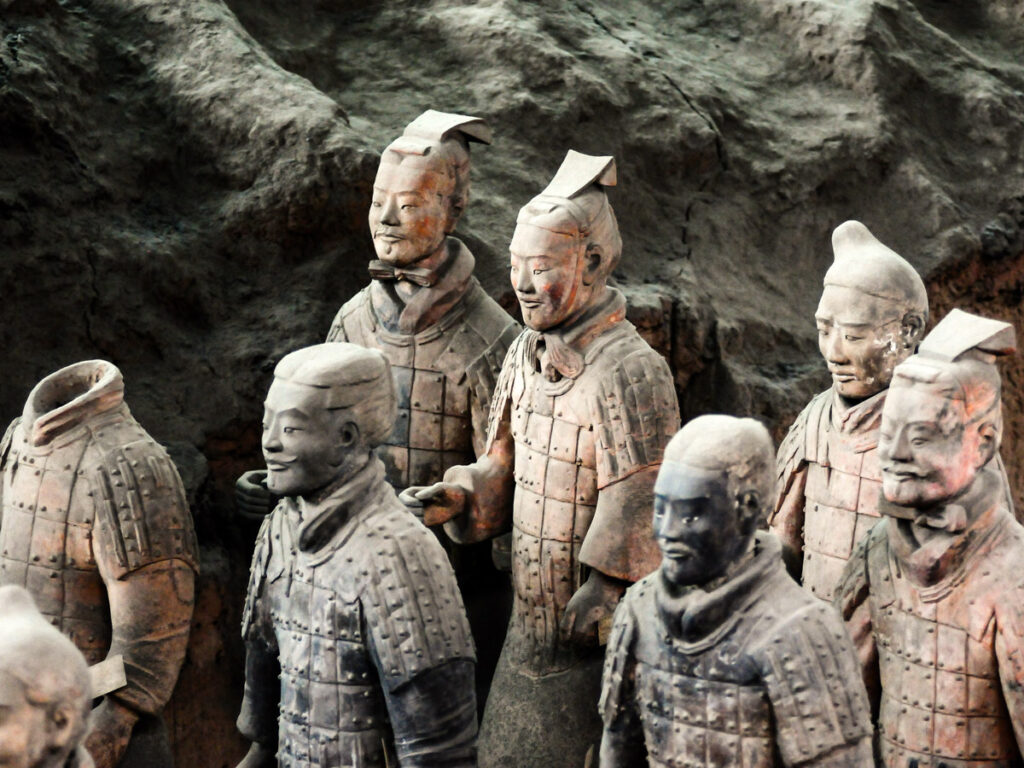
You can’t go all the way to Xi’an without taking a day-trip to the Terracotta Warriors – plan time for it on your China itinerary.
This ancient army dates back to the first emperor of China, Qin Shihuang, and is China’s equivalent to the pyramids.
Here you can see row upon row of life-size terracotta warriors in giant pits.
Altogether, with the bus ride and visiting the site, you’ll want to budget your morning and afternoon for this day-trip.
See all the tour options and availability for the Terracotta Warriors here.
Hua Shan
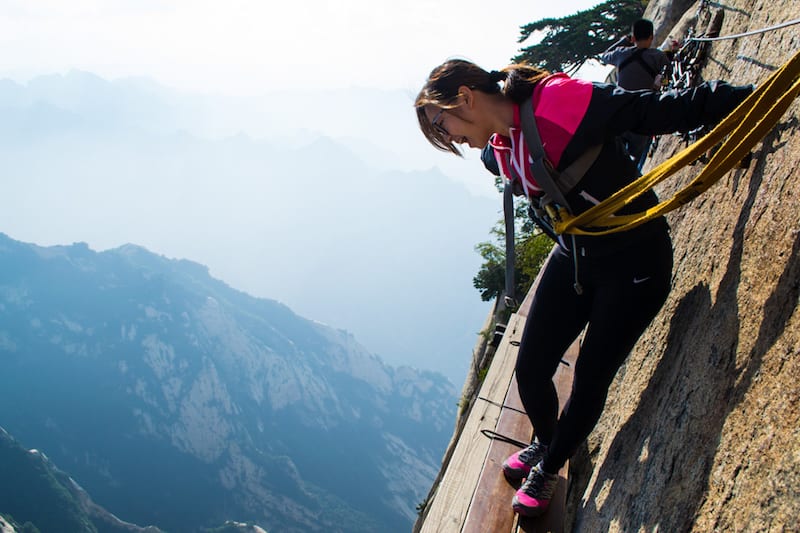
If you can manage to squeeze in a day-trip to Hua Shan, then I 100% recommend it!
Take a harrowing cable car up the side of the mountain, to embark on the “world’s most dangerous” hike.
Here you can find the infamous Hua Shan plank walk, where you’ll strap yourself into a harness and walk along a plank embedded into the side of a cliff.
The view down is enough to make your heart beat out of your chest, it’s one of the craziest things to do in China, but the experience is worth it!
Where to stay in Xi’an
- The highly rated Eastern House Boutique Hotel offers oriental-style guestrooms in Xi’an downtown, around a 5-minute walk from Xi’an City Wall. See rates and availability.
- Hantang Inn Hostel Xi’an is located in the center of Xi’an. It combines Chinese and Western designs. See rates and availability.
- Located besides Tang Paradise, a 9-minute drive from Giant Wild Goose Pagoda, Gran Melia Xian offers accommodations in Xi’an, featuring private gardens, a lake and an international brand shopping mall, indoor pool and spa center. See rates and availability.
Day 7-8: Jiuzhaigou and Huanglong
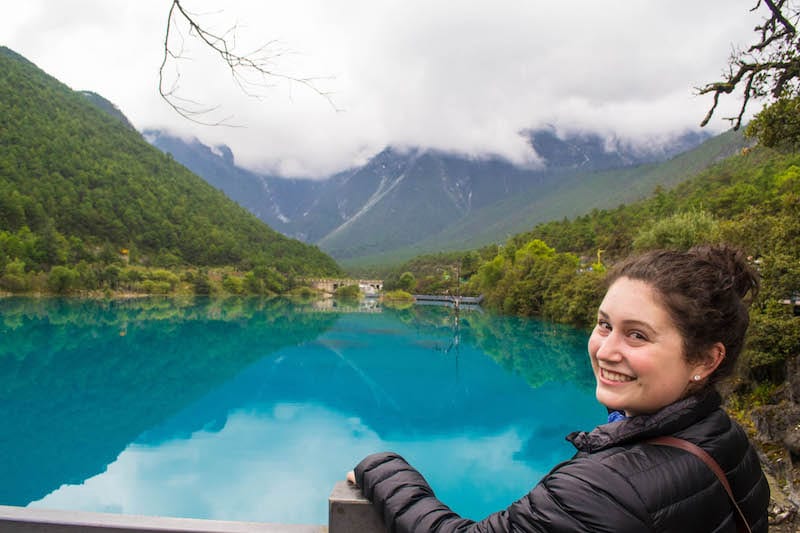
Jiuzhaigou in northern Sichuan province is one of the most beautiful places I’ve ever been, and one of the best places to visit in China.
Hike all day through crystal-clear lakes and rivers that reflect the bright blue sky.
Here you’ll be able to see all the way down to the bottom of each lake, and capture photographs most people could only dream of.
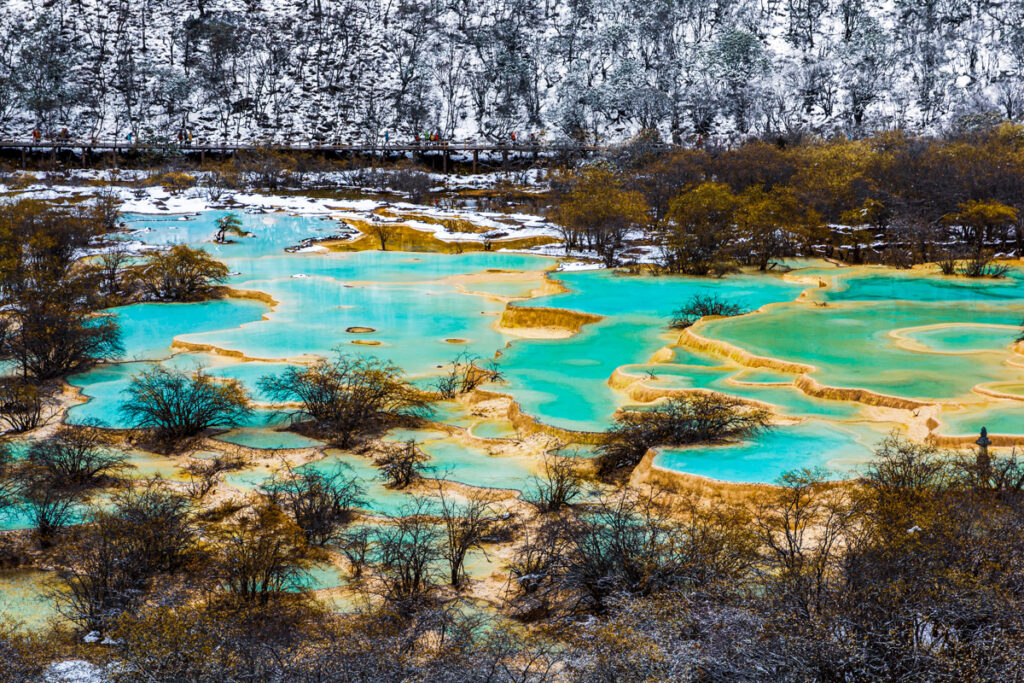
The next morning head to Huanglong, which is known for its colorful calcite deposit pools. These sky-blue mushroom-cloud pools make it obvious why many Chinese people call Huanglong a “fairyland”.
Where to stay in Jiuzhaigou
- Located near the Jiuzhaigou Nature Reserve, InterContinental Resort Jiuzhai Paradise is about 35 minutes’ drive from Jiuzhaigou Valley National Park, a UNESCO World Heritage site. See rates and availability.
- Jiuzhai morning hotel is a 10 minute walk from the entrance to Jiuzhaigou. See rates and availability.
- Located in Jiuzhaigou, Rissai Valley, the more lux Ritz-Carlton Reserve features a garden, terrace, bar, and free WiFi throughout the property. See rates and availability.
Day 9: Horse trek in Songpan
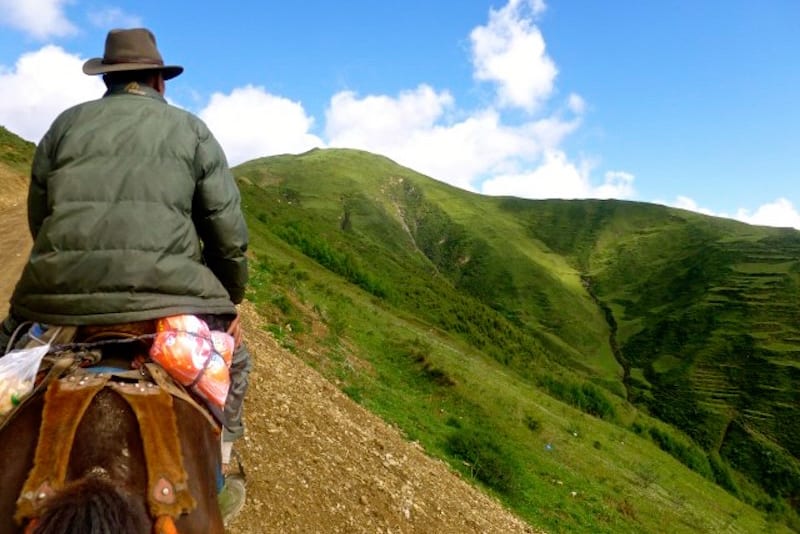
If you love riding horses, you’ll definitely want to put this on your China itinerary and take a one-day horse trek on the Tibetan plateau.
The cute mountain town of Songpan, just near Jiuzhaigou, is home to day and overnight trips on horseback.
Travel with a local Tibetan guide, and explore parts of China that most tourists will never see.
Day 10-12: Chengdu
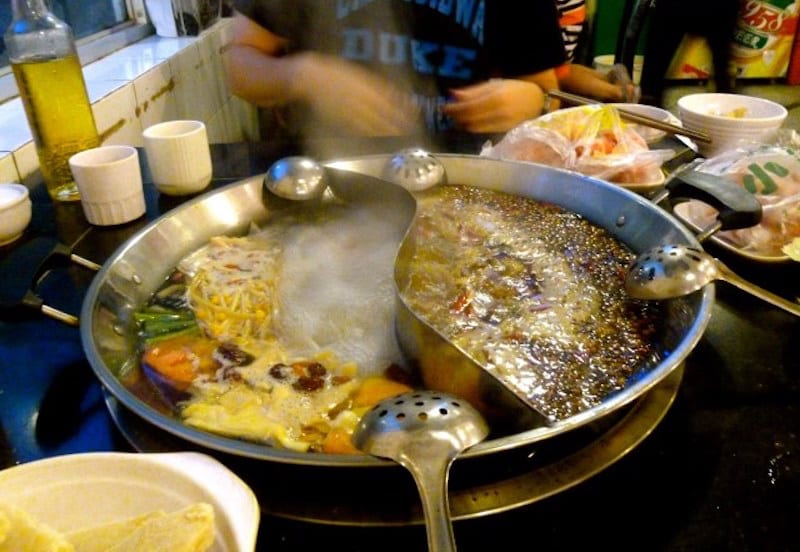
After a quick flight or a 4-6 hour bus ride down to Chengdu, you’re going to want to spend the afternoon exploring the beautiful gardens and teahouses in this scenic city.
For your first evening, I also highly recommend going for hot pot, a famous eating experience from Sichuan and Chongqing.
Don’t worry, they have non-spicy broth for those who can’t handle the heat!
Leshan Buddha day trip
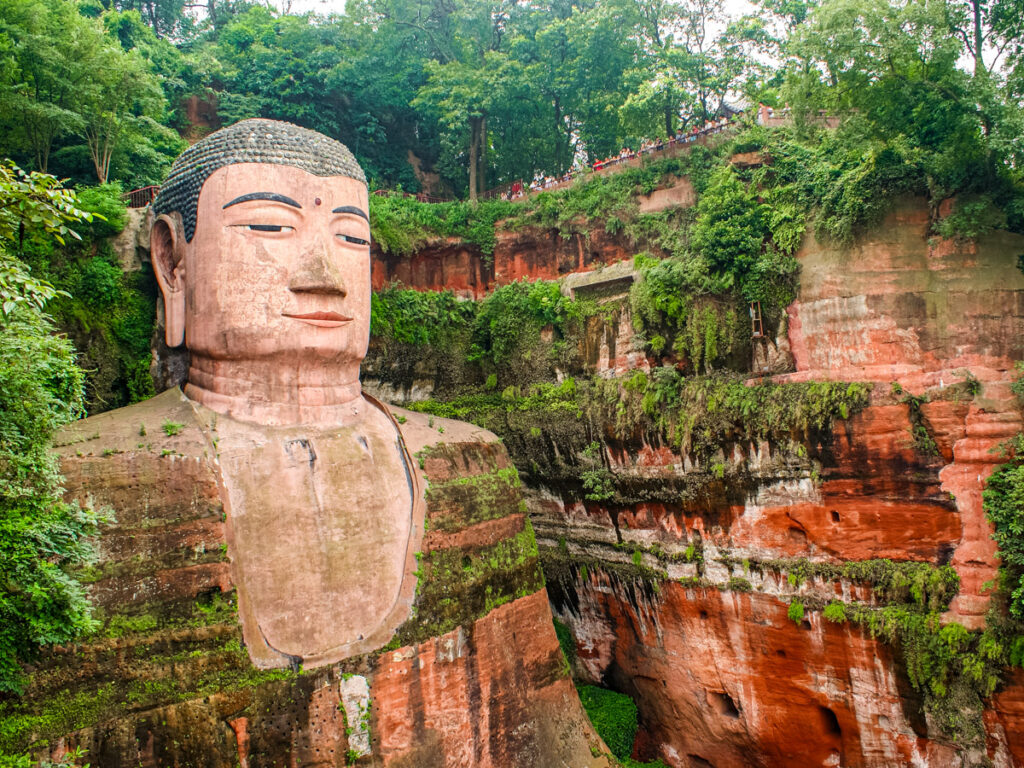
When in Chengdu, you’ll need to take a trip to the Leshan Buddha, the largest carved stone Buddha in the world.
You can easily hop on a day trip from your hotel, or take one of the many tourist buses there and back.
This Buddha is definitely worth the two-hour trip to see its massive scale. I’m about the size of one of his smaller toes!
The Panda Reserve

If you visit Chengdu, you definitely can’t miss the Panda Reserve, it’s one of the best things to see in China.
Be sure to head there in the morning, when the giant pandas are most active. Catch them eating bamboo, playing with one another, and sleeping in trees. Who knew little pandas love to sleep in trees?
You’ll also need to head to the baby area, where they have the youngest pandas playing with toys and rolling around.
Trust me, the Panda Reserve will definitely be a highlight of your trip. You can take a private tour here.
Where to stay in Chengdu
- Ascott Raffles City Chengdu offers luxurious apartments with free Wi-Fi throughout the property. The apartments all feature upscale amenities and some units are fully equipped kitchen. See rates and availability.
- Located along the historic Qintai Path, Chengdu Wenjun Mansion Hotel (Kuanzhai Xiangzi Branch) is decorated in a traditional Chinese style, a 5-minute walk from Tonghuimen Subway Station (Line 2). See rates and availability.
- Set in Chengdu, ideally located next to Jinjiang River, Shangri-La Chengdu offers well-equipped guest rooms with stunning city views, elegant restaurants and a luxurious ballroom. See rates and availability.
Day 13: Beijing
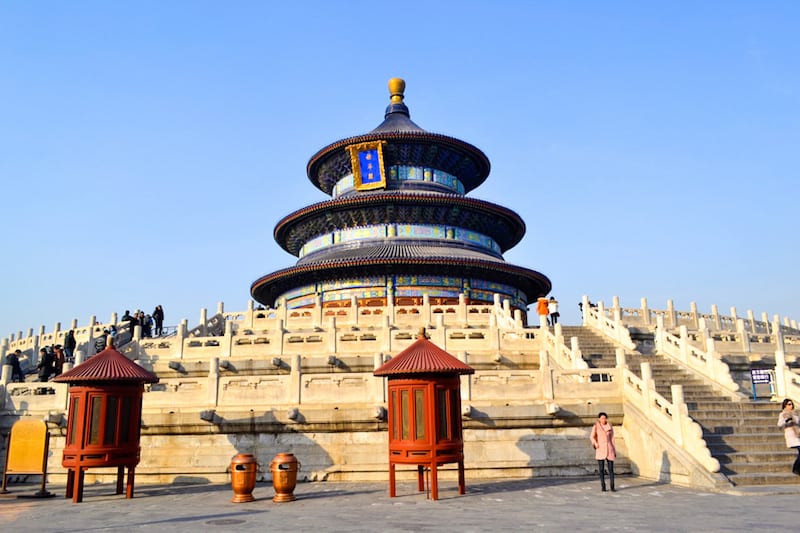
For your last day in Beijing, I recommend visiting the Temple of Heaven, my favorite imperial site in the country and one of the top China tourist attractions. You can take a guided tour here if you want to go deeper into the history of this fascinating UNESCO World Heritage site.
Afterwards, you can head over to the Pearl Market, one of my favorite bargaining markets in Beijing.
Stock up on sunglasses, electronics, silk, pearls, and a new suitcase to get all of your shopping home!
I know what you’re probably thinking. Wait… no Shanghai on this list of places to go in China?!
Personally, I’m not a huge fan of Shanghai as a tourist city.
My decision to skip it might be pretty controversial, but I honestly think there’s much more to do and see for a traveler in Beijing, than in Shanghai.
Besides, it’s always much cheaper to get a round-trip flight in and out of the same city.
However, if you really want to visit Shanghai before you leave, I have an optional Shanghai ending in this itinerary as well.
Just keep in mind, you’ll only want to head to Shanghai if you can actually sightsee on day 14, instead of using day 14 to fly home.
Day 13-14: Shanghai

If you really want to spend some time in Shanghai, make sure you have two full days at the end of your trip to China to give this mega city justice.
Of course, you’ll need to see the Bund.
You may want to stop by a few other famous sites like the Yu Yuan Gardens and surrounding area, Jing’an Temple, and the French Concession.
I also highly recommend slurping on a plate of soup dumplings while in Shanghai.
Many people say that the best soup dumpling place is just outside the Yu Yuan Gardens (you’ll find the line without even trying), but personally, I recommend going to a small local place outside of a touristy area to get an authentic experience.
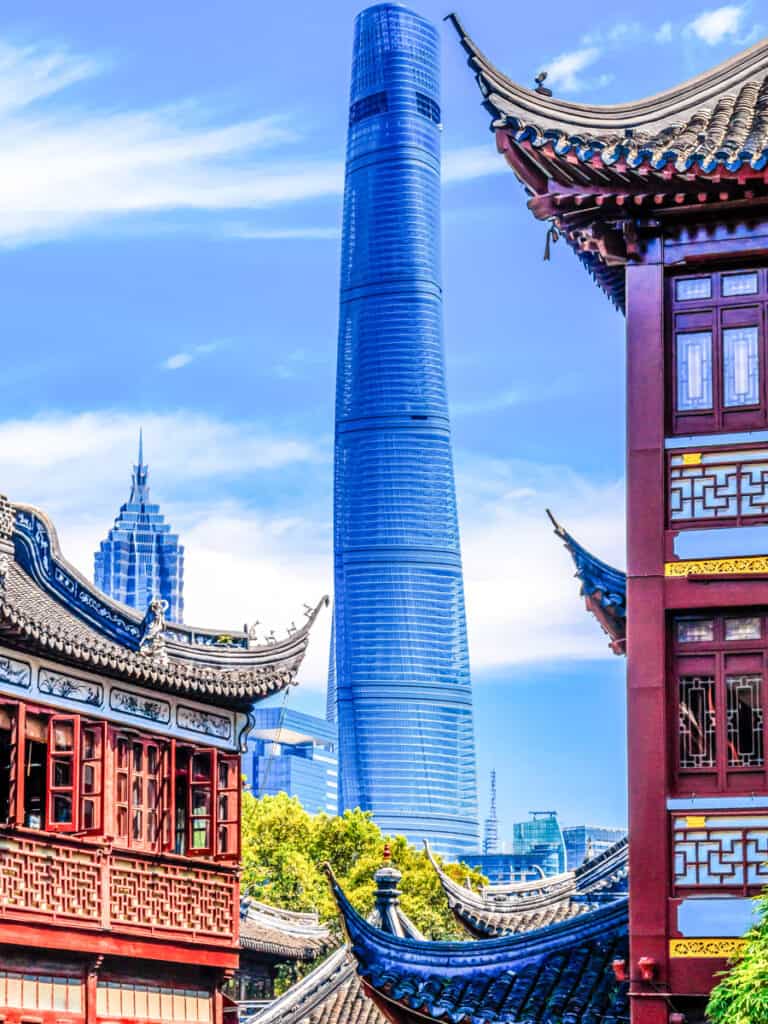
Finally, if you want a great view of the city you can go up in one of Shanghai’s iconic buildings.
I’ve only been up in the JinMao Tower, but I’m dying to visit the Shanghai World Financial Center because they have a glass-bottom floor!
From either of these skyscrapers, you can see all of the surrounding city, and the world-famous Pearl Tower right next door.
Where to stay in Shanghai
- If you’re on a budget, I recommend the Shanghai Hidden Garden Hostel. The location in Pudong is right where everything is happening, as well as being opposite the Bund.
- On the high end, the Langham Hotel in Xintiandi is a great choice. Their service is great and they are right by all the nice shopping and dining venues.
Getting Around China
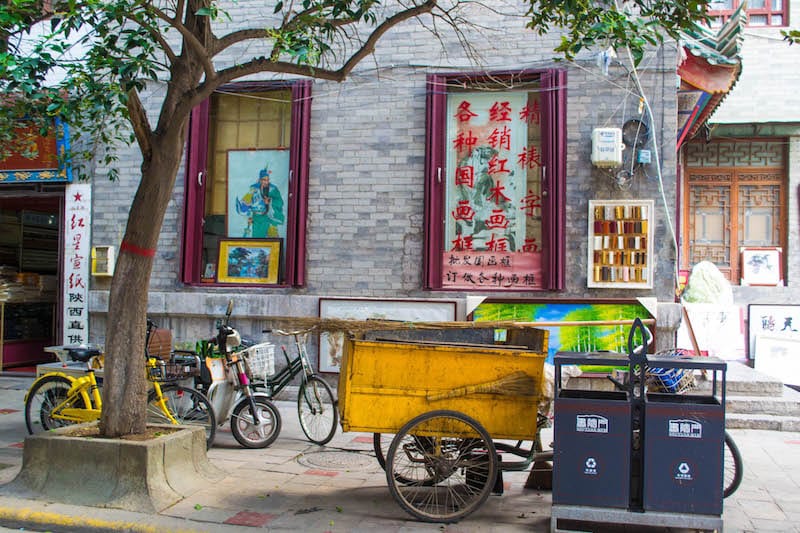
Navigating China can feel overwhelming, but it’s pretty easy to get from place to place.
The best way to get around China is by China’s extensive high-speed train network, connecting major cities with comfort and convenience. 12Go is a good resource for ticketed travel in China.
For shorter distances within cities, you can find small local buses, or within cities, there is usually a metro. Taxis are plentiful and cheap, though the drivers rarely speak English.
Alternatively, hail a “Didi,” China’s answer to Uber.
Tips for Visiting China
Before you start booking attractions and hotels, here are a few things you need to know before you go…
- Get a VPN! China is famous for having the Great Firewall over the country, which means social media apps such as Whatsapp, Facebook and Instagram are blocked, as well as most Google products – Google Maps, Google Translate, Gmail…everything. You will struggle to use the internet without a VPN.
- Get train tickets in advance. There is usually a long line for tickets at the station and when traveling between cities, good seats get booked up in advance.
- Plan to visit in April or October, these are the quieter months and have good weather.
- Be prepared for the language barrier. Have important addresses written down in Chinese characters to show taxi drivers or ask for directions.
- Carry your own essentials. Items like toilet paper, napkins, and hand sanitizer may not always be readily available, so it’s wise to have them on hand.
- Be prepared for the squatty potty.
- You can also get really cheap eSims from Airalo. You can set it up so it’s ready to go as soon as you arrive. That way you don’t have to worry about finding a local sim card. See prices and availability here.
Final Thoughts
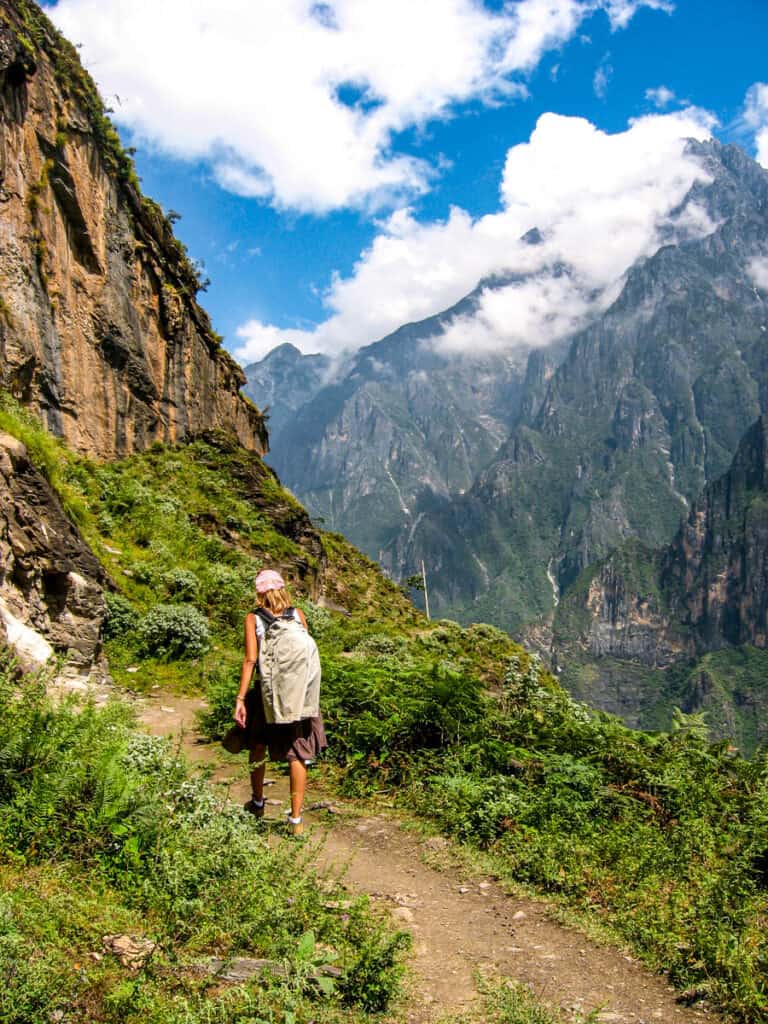
Obviously, with a country as large as China, there are so many options for where you should spend your two weeks.
If you prefer nature, substitute Sichuan with a week in Yunnan and experience the Longji Rice Terraces or hike the Tiger Leaping Gorge, one of the world’s deepest gorges known for its incredible mountain views and scenes of the Yangtze River.
Or end your trip in Guilin and Yangshuo, where you can simply rent a bike and cycle through the countryside.
There are far too many incredible places to visit in China, and the unfortunate reality is that it’s impossible to see everything in a few months, let alone two weeks!
However, this China itinerary will create an incredible trip around China and is designed to give you a great introductory visit.
You’ll get a peek at China’s politics, history, culture, pandas, cuisines, and natural beauty.
You’ll explore the biggest cities, and smallest countryside towns, all while following a schedule that gives you time to appreciate each place.
Traveling to China can be daunting, and while there is no such thing as a perfect two week China Itinerary, in my opinion, this one is as close as it gets!
Pin This To Share On Pinterest
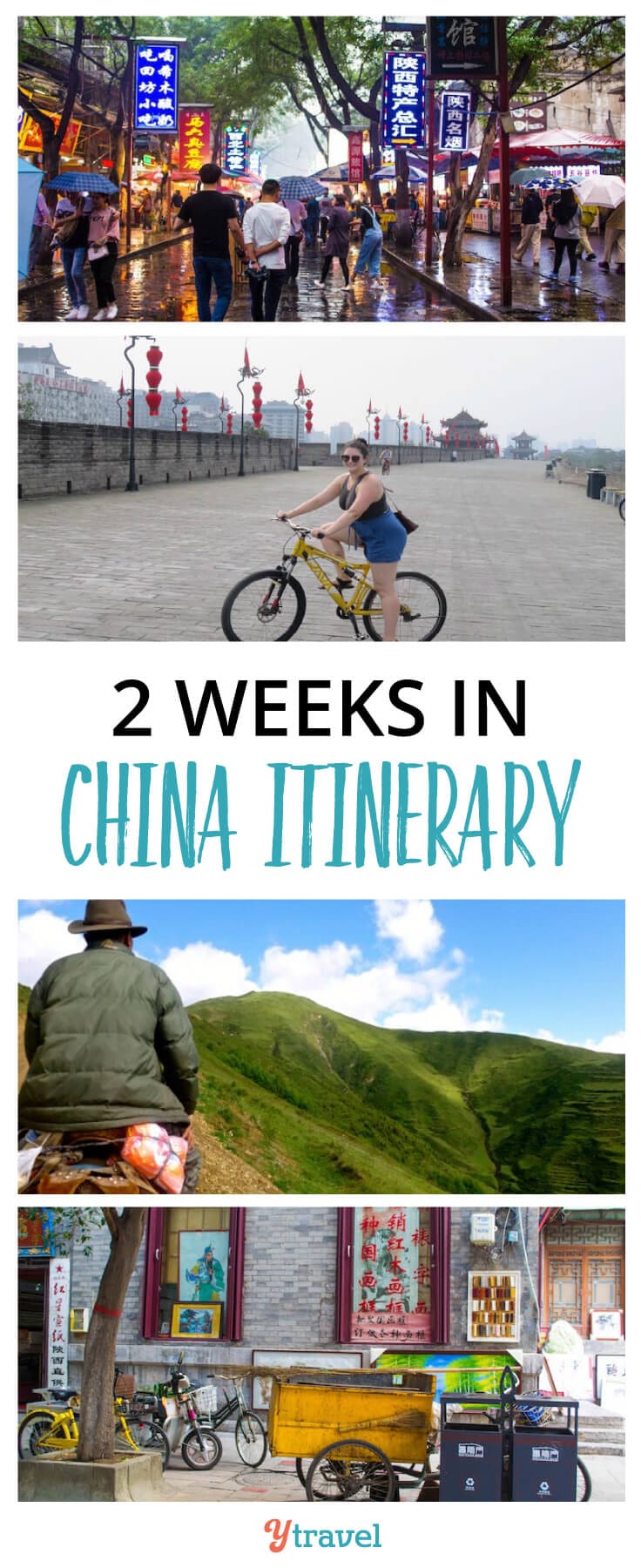

I hope this two-week China itinerary helps you plan your own China trip. If you have any China travel tips, please share in the comments.
[ad_2]
Source link
